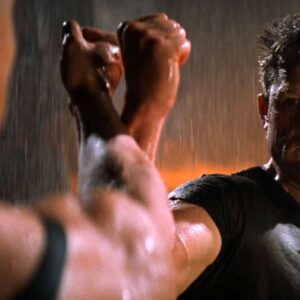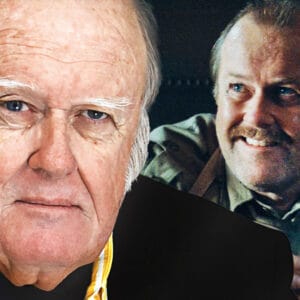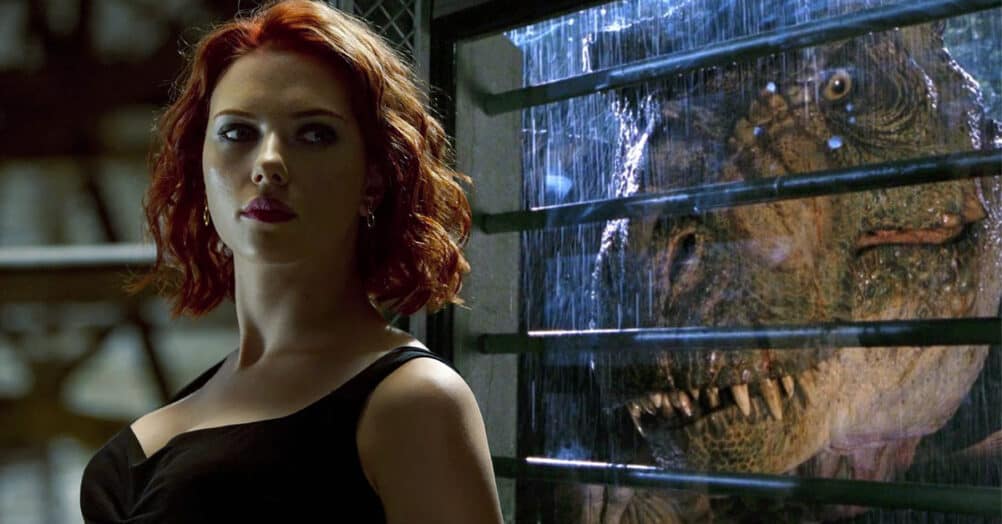Last Updated on August 2, 2021

My favorite films, especially in the science-fiction genre, are those that stick with you for hours after you leave the theater. EX MACHINA, written and directed by Alex Garland, is one of these films. Completely original, wonderfully acted, and a mind-f#*k like you wouldn’t believe, this movie didn’t just stick with me for hours after I left the theater, I am still thinking about it weeks later.
EX MACHINA is easily my favorite film so far in 2015, so I was excited to sit down with Garland to ask him a few of my most pressing questions. And although I only had about fifteen minutes with him, I could have continued firing away for at least another couple of hours. We talked about subtle Easter eggs that you can look out for onscreen, as well as how he used visual effects to get Ava’s (Alicia Vikander) look. But beware, there are spoilers so read at your own risk or bookmark this to read after you watch the film!

EX MACHINA is my favorite movie of the year so far, so I am really excited to talk to you about it.
Alex Garland: Thank you very much. I appreciate that.
I noticed there were a lot of subtle Easter eggs in the film, like I didn’t catch Ava blinking…
AG: She probably does a few times, but we took a lot of that out.
You did? So that was something you thought about regarding her not blinking?
AG: It’s interesting. I think outside of someone who has worked on the film, you’re probably the first person that has mentioned it because where that sort of stuff gets aimed is almost on an unconscious level. It’s actually the way Alicia [Vikander] does a lot of her performance. It’s too perfect. People aren’t like that. They don’t sit like that. They don’t rise like that. Like the way I am slouched [in this chair] is more normal. It’s not like you look at her and think she’s acting. She’s moving in a weird way, but there’s a sense of otherness that makes you think it’s right but it’s wrong. The blinking thing is a bit like that. The funny thing about blinks is that they often take them out of films because an actor blinks at the wrong moment and it slightly blows the [scene]. You can drop the frames out, usually, because a blink is so quick, you can’t tell. It’s not even a visual effects [element]; you can just get rid of the frames. It’s cool.
Were there any other subtleties that you put in the film that the average viewer may not pick up on? What was your favorite?
AG: Oh, I hope! In intention there are millions. And it’s not just me putting them in the film; it’s everyone putting them in the film. That thing I just said about Ava’s movement – that was Alicia. There were so many people working on the film and so many people were working at such a high level. There were things like – and again, this wasn’t me; this was Michelle Day, who was in charge of props, dressing the set and choosing what objects go in the set. Obviously it’s a discussion, but it’s Mich that’s driving it. I’ve worked with her on every film I’ve worked on. There are five movies that we’ve worked on together and she’s really special. The thing about what Mich does is that she does stuff that directors get the credit for because nobody knows what people like Mich do and what they’re responsible for. At the end of this film, she actually has a card credit because I thought she’s got to be more acknowledged for the impact she [had on the film]. That’s normally a job that’s in the roller. Remember towards the end of the film – I’ll say it in a non-spoilery type of way – Ava, wearing a white dress, walks past a painting of a woman in white dress?
Yes! I totally remember that part.
AG: The painting is by Gustav Klimt, and Nathan (Oscar Isaac) has tons of fantastic art in his house because he’s a rich guy who likes art. So she walks past this painting – and I hope I’m remembering this right – the painting is of Wittgenstein’s sister. Wittgenstein is the philosopher that is used as the basis for lots of the stuff within the film. And the name of Nathan’s company, Blue Book, is based on some of Wittgenstein’s notes. So Ava, at that moment, is wearing a white dress that echoes the painting. There are all of these strands being drawn together and that was Mich doing the research into art, into Wittgenstein, into finding this beautiful painting, and knowing which wall to put it on. She knows because she has a nuanced understanding of where a director and director of photography are likely to want to put a camera. She’s thinking about all of that. Mich, because we know each other very well, sometimes puts these things in as surprises. I didn’t know that was going to be there until I walked onto the set and there it was. My jaw dropped. I thought it was such a smart, elegant, beautiful idea and immediately me and Rob [Hardy], the DoP, start saying we have to do a shot where Ava walks past. Mich is really the one that created that moment. Me and Rob might capture it, but it’s Mich’s brain that it came out of. That’s probably my favorite.

I really like that one a lot too! I am going to look out for that scene when I watch the film again. So how were you able to get Ava’s look? Were green screens involved?
AG: No. The film I just worked on before this one had a lot of VFX in it – DREDD, a dystopian cop movie that was set in this futuristic city. There were lots of set extensions and views through windows that didn’t really exist. Corridors were on a soundstage, so they were only twice the length of this room, but in the film it looks like they go on for 200 meters. So there was green everywhere and tracking markers. But in [EX MACHINA], Andrew Whitehurst, the guy who was running the VFX, who I sometimes think is the smartest guy I’ve ever met, said, ‘We’ve got the design of the robot. Don’t think about the visual effects aspect. Just shoot it. We aren’t going to put green up anywhere. There will be no tracking markers. Just shoot it like a drama. We’ll make it work.’
So Alicia was wearing what you see here [points to the bodysuit on the movie poster]. It looked like a Spider-Man costume. It was wrapped around her whole body, including her head. She had a prosthetic, which was [on the outside of] her face, and this grey mesh that went all over her body except her hands and feet. Then the VFX guys, in post-production, swapped that out. Her legs were swapped out as well. That was the process. In design terms, the key thing was this mesh, in terms of the way she looked, because it meant the first time you saw her, she’s obviously a machine. There’s no game being played – no trick. If she were wearing a full body suit, you might ask the question, “Is she really a robot?” What this does is makes it beyond any doubt that she’s a machine. But at the same time, [the mesh] is a bit like a spider web, which catches the light. And sometimes it’s invisible and you could walk through it and suddenly have it wrap around your face. Other times, when you see it against a black background and it’s side-lit, it’s perfectly picked up. This is like a spider web, where when the light catches it, suddenly the shape of Alicia’s torso will appear in a sort of fleeting glance in a way. It alludes to yes, she’s a machine, but it’s also pulling you toward the idea to stop thinking about her like a machine and start thinking of her more like a girl.
That’s so interesting. I definitely got that when I was watching the film. And going off of that, it was interesting to me that you showed Caleb [Domhnal Gleeson] checking to make sure that he, himself, wasn’t a machine. I was pleasantly surprised that he wasn’t, because I really thought I had guessed the big twist. Can you talk about your decision to include that scene?
AG: It’s deliberate because I know that audiences have probably seen BLADE RUNNER, or have probably seen any other films that would lead them towards thinking the test is really on Caleb and he is really the machine. So I knew that a certain kind of sci-fi literate audience was going to suspect that. I also knew that they were going to say, ‘This Japanese lady is really a robot and I’m smart enough to figure that out.’ And so that is like a misdirection so people relax. They figure that they’ve got the twist and they stop looking at what the actual thing is. The film actually discretely nudges people toward thinking that. For example, Caleb has these strange symmetrical scars on his back that feel like they’re not quite from an accident. He’s got some backstory about a car crash, but is that an implanted memory? And the office where he comes from, it’s like a dream when you’re there. Did he actually get activated in the helicopter and this is an implanted memory? They’re things like that that are gently pushing you towards thinking that he might be a machine. It allows Ava to secretly be the protagonist of the film, which is what she is. It’s her movie. That’s why she’s on the poster. In my way of seeing it, she’s kind of like the hero.
I completely agree. Even though I felt bad for Caleb at the end of the film, I absolutely loved the choice Ava made.
AG: Sure. You see, I think this is about where you choose to position yourself. I position myself next to Ava. That’s where I am. I’m looking at this film through her eyes, effectively. So what you’ve got is a sentient creature with emotional, internal life, just like us, trapped in a glass box. There’s a jailor and the jailor is pretty malevolent, pretty creepy, and pretty scary. Then there’s the jailor’s friend and the friend may or may not be trustworthy. It’s hard to say. But if you see a guy that can be your route out of [the box], you use him to get out and that’s legit. That’s fair enough. I don’t have either an ethical problem with that or an emotional problem with it. Then there are those that say they position themselves with Caleb because he’s a decent guy. He turns up; he wins a lottery ticket; he meets this machine, who then is effectively seducing him. So I get where people are coming from that feel that way, but it’s just not how I see it and I don’t think that’s how the film presents itself. If you look at the grammar of the filmmaking, the way the camera sits with Ava, where it cuts away and doesn’t cut away, I think it’s subtly always with her, really.

One last question before they wrap me up. Do you think Ava ever really loved Caleb?
AG: Me and Alicia used to talk about this. I was a bit harder about it than she was. I would say no. I would say she is in a prison, she sees a means to get out, and this place is scary and she wants to get out. That’s how I saw it. Alicia had in her mind, and this is totally fair enough, another narrative where she was connecting with Caleb. And then there’s a point, which she could talk about better than me, where Caleb basically says the wrong thing and suddenly Ava pulls back. He gives the wrong answer to a question, and suddenly she feels like she needs to rely on herself. When Alicia said that, I thought it was a really beautiful argument. My philosophy with stories is that I have my version, but other people can have theirs and that is cool, so I actually really loved Alicia’s version.
What part of the film was that? Do you remember?
AG: I can’t remember the exact line, but I think it’s in their third session together. It’s when she’s saying, ‘What’s going to happen to me if I get switched off?’ Caleb hesitates over some of her questions, and she knows that he knows the answer. She thinks he’s ambivalent and isn’t sure where he is [mentally] and she needs to be sure because she needs to get out.
Thanks so much for talking to me. Again, I really loved the movie and could talk to you about it for hours.




















Follow the JOBLO MOVIE NETWORK
Follow us on YOUTUBE
Follow ARROW IN THE HEAD
Follow AITH on YOUTUBE